I am trying to set up a linear programming solution using lpSolveAPI and R to solve a scheduling problem. Below is a small sample of the data; the minutes required for each session id, and their 'preferred' order/weight.
id <- 1:100
min <- sample(0:500, 100)
weight <- (1:100)/sum(1:100)
data <- data.frame(id, min, weight)
What I want to do is arrange/schedule these session IDs so that there are maximum number sessions in a day, preferably by their weight and each day is capped by a total of 400 minutes.
This is how I have set it up currently in R:
require(lpSolveAPI)
#Set up matrix to hold results; each row represents day
r <- 5
c <- 10
row <- 1
results <- matrix(0, nrow = r, ncol = c)
rownames(results) <- format(seq(Sys.Date(), by = "days", length.out = r), "%Y-%m-%d")
for (i in 1:r){
for(j in 1:c){
lp <- make.lp(0, nrow(data))
set.type(lp, 1:nrow(data), "binary")
set.objfn(lp, rep(1, nrow(data)))
lp.control(lp, sense = "max")
add.constraint(lp, data$min, "<=", 400)
set.branch.weights(lp, data$weight)
solve(lp)
a <- get.variables(lp)*data$id
b <- a[a!=0]
tryCatch(results[row, 1:length(b)] <- b, error = function(x) 0)
if(dim(data[!data$id == a,])[1] > 0) {
data <- data[!data$id== a,]
row <- row + 1
}
break
}
}
sum(results > 0)
barplot(results) #View of scheduled IDs
A quick look at the results matrix tells me that while the setup works to maximise number of sessions so that the total minutes in a day are close to 400 as possible, the setup doesn't follow the weights given. I expect my results matrix to be filled with increasing session IDs.
I have tried assigning different weights, weights in reverse order etc. but for some reason my setup doesn't seem to enforce "set.branch.weights".
I have read the documentation for "set.branch.weights" from lpSolveAPI but I think I am doing something wrong here.
Example - Data:
id min weight
1 67 1
2 72 2
3 36 3
4 91 4
5 80 5
6 44 6
7 76 7
8 58 8
9 84 9
10 96 10
11 21 11
12 1 12
13 41 13
14 66 14
15 89 15
16 62 16
17 11 17
18 42 18
19 68 19
20 25 20
21 44 21
22 90 22
23 4 23
24 33 24
25 31 25
Should be
Day 1 67 72 36 91 80 44 76
Day 2 58 84 96 21 1 41 66 89
Day 3 62 11 42 68 25 44 90 4 33 31
Each day has a cumulative sum of <= 480m.

